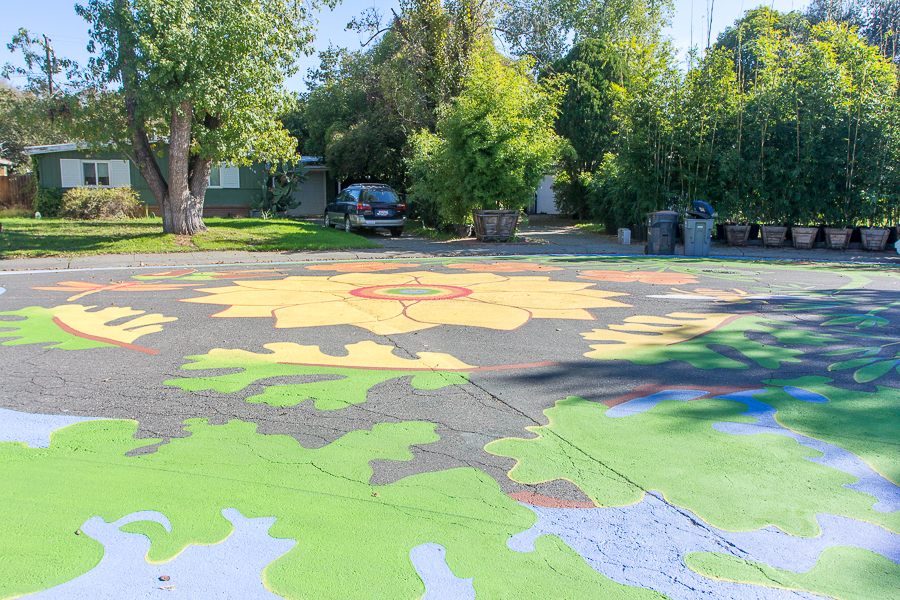
Davis Manor neighborhood’s newest street addition
What started a couple of years ago as a spark of interest to improve the Davis Manor neighborhood, ignited the idea to create a street mural. Throughout the process, those working on the mural came to the realization that building community relations was just as important as completing the finished work.
About a year and a half ago, the Davis Manor Creative Action Team (CAT) drafted a proposal for a grant to obtain some of the necessary funding to make its mural project a reality. In this proposal, UC Davis alumna and local artist Danielle Fodor was chosen to help out with the mural’s painting. In addition to receiving significant donations from businesses and individual fundraising, the Civic Arts Commission awarded the group a grant of approximately $4,000.
The idea for this mural originally stemmed from Mark Lakeman, head of The City Repair Project in Portland, Or.. While Lakeman was in the area, the Davis Manor Council invited him to speak about his organization, which had goals to reclaim public areas and fill them with artwork which spoke to the community and drew people together.
“I met with community members maybe more than a year and a half ago to talk about the whole concept of community art and localized street design issues that can enhance community,” said Davis mayor Robb Davis. “And I was very supportive about them being experimental and coming to us with ideas, even if it meant changing street configuration.”
After obtaining the necessary budget as well as community support to complete the project, the council began to plan out three workshops during which community members could gather to voice their design ideas. This enabled the public to decide what was really important to them and what neighborhood values they thought were most meaningful.
“At first, the ideas all seemed really different and impossible to put together,” Fodor said. “But what it really comes down to is [that] you end up talking about the core values of your community, and they always end up overlapping. And as we started working together, the design really starts to coalesce.”
An average of 20 people attended each of the workshops, but when it came to the final paint days, there were about 150 people. The mural, which was originally supposed to be 1,400 square feet, ended up at about 5,000 square feet due to the vast number of ideas that residents kept incorporating into the mural’s planning process.
“This is a community that really cares about inclusion, they really care about diversity, they really care about creativity,” Fodor said. “And so it really made sense for them to have a design that had lots of little things going on that were all connected but were also allowed to sing their own song –– to be what they were going to be individually.”
Community members of all ages were allowed to be a part of the painting process, whether or not they had any prior artistic experience.
“There were probably 5-year-olds painting all the way up to 80-year-olds painting, or maybe even older,” Davis said.
Parents, their children and UC Davis students ranging from local to international all helped paint, and other artists even came from as far as Rancho Cordova, Calif..
“People go to being neighbors, rather than people who just happen to live by each other,” said Rachel Hartsough, arts and culture program manager for the City of Davis. “[The mural] affects the people in that neighborhood for sure. It gives people a sense of how we can come together and have a big impact on working collaboratively, whether in arts or other facets in our community.”
A potluck dinner was thrown for the mural that Friday, Oct. 20 and Saturday, Oct. 21, with live music adding to the already jubilant mood. Many were excited about the mural because it would be a place where people could meet, hang out or simply come to enjoy its beauty.
“We missed out on having some of the public parks and other amenities that other neighborhoods had,” said Robin Kozloff, a Davis Manor neighbor who helped to facilitate the mural. “We sort of need a place to gather, and so a mural on the street could actually provide that.”
What was really special about this mural was that a water-based asphalt coating was used, which has a relatively short shelf-life. Comparatively, normal acrylic has a shelf life of a couple years. The use of this shorter shelf-life coating was the first time that this medium had been used for murals in Davis, and will last longer than other paints and prevent it from deterioration due to weathering.
A significant amount of research, planning and time was poured into the street mural project, which served to unify the community.
“These community projects are always really humbling to me because we think that we’re so big and powerful, and that the decisions we make are so important,” Fodor said. “But really, it’s the decisions we make as groups, and it’s when we work together, that we’re able to reach beyond our wildest dreams.”
Written by: Kaelyn Tuermer-Lee – city@theaggie.org




